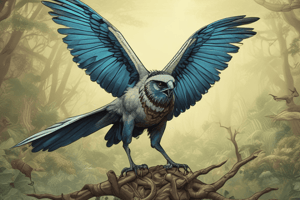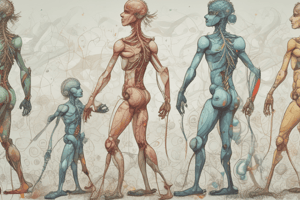Podcast
Questions and Answers
What is the distinguishing feature of Galapagos tortoises?
What is the distinguishing feature of Galapagos tortoises?
- The number of their legs
- The color of their skin
- The shape of their shells (correct)
- The size of their bodies
Which bird is native to Australia?
Which bird is native to Australia?
- Emu (correct)
- Galapagos tortoise
- African ostriches
- Rhea
Who independently came up with the idea of natural selection?
Who independently came up with the idea of natural selection?
- Charles Darwin
- Alfred Wallace
- Kofi Owusu-Daaku
- Alfred Russel Wallace (correct)
What is the title of Charles Darwin's book that sparked wide debate and discussion of natural selection?
What is the title of Charles Darwin's book that sparked wide debate and discussion of natural selection?
What year did Charles Darwin and Alfred Wallace publish their joint presentation on natural selection?
What year did Charles Darwin and Alfred Wallace publish their joint presentation on natural selection?
What is the specialty of Kofi Owusu-Daaku?
What is the specialty of Kofi Owusu-Daaku?
What is the birth year of Alfred Russel Wallace?
What is the birth year of Alfred Russel Wallace?
How long did Charles Darwin put off publishing his thoughts on natural selection?
How long did Charles Darwin put off publishing his thoughts on natural selection?
What is the name of the bird native to South America?
What is the name of the bird native to South America?
What is the death year of Alfred Russel Wallace?
What is the death year of Alfred Russel Wallace?
Flashcards are hidden until you start studying
Study Notes
Evolution of the Environment
- The evolution of the environment with definite biosphere zones facilitated the evolution of higher animals, including humans.
- Oparin (1938) suggested the following phases of evolution:
- Atomic phase
- Molecular phase
- Organic phase
- Colloidal phase
- Autocatalytic phase
- Primordial cellular phase
- Autotrophic phase
- Prokaryotic phase
- Eukaryotic phase
Origin of Life
- The Earth is also known as 'the blue planet' or 'the planet with life', originating about 4.8 billion years ago.
- The primitive atmosphere of the Earth contained nitrogen, hydrogen, and carbon, but no oxygen or ozone, all found in the atomic state due to extreme heat and ultraviolet insulation.
- Chemical evolution continued for about 2,000 million years, resulting in the appearance of various inorganic and organic compounds, including N2, H2, CH4, NH3, CO, CO2, H2O, etc.
Lamarckism
- Lamarckian theory is also known as the 'Theory of Inheritance of Acquired Characters' or the 'Theory of Use or Disuse of Organs'.
- According to Lamarck's theory, as giraffes stretched to reach high branches, their necks lengthened, and this was passed on to their offspring.
- The basic ideas of Lamarckism are:
- Complex plants and animals are produced from simpler ones over time under the influence of nature.
- Living organisms have a tendency to continuously increase in size.
- There is a change in the needs of an animal due to changes in the surrounding environment, resulting in the formation of new organs to cater to the needs of the animal.
- If an organ is used continuously, it will become more powerful, but if it is not used for a long time, it will gradually weaken and eventually disappear.
- The characters acquired during the lifetime of individuals will be transmitted to the next generation.
Critical Analysis of Lamarckism
- Lamarck based his idea of use and disuse on the evidence of vestigial organs and rudimentary organs.
- Weismann (1890) provided experimental proof against the assumption of inheritance of acquired characters.
- Weismann proposed the 'Theory of Continuity of Germplasm', stating that only changes in the germ cells are inherited, and somatic changes are not inherited.
Neo-Lamarckism
- A few scientists, notably Herbert Spencer, Haeckel, Gadow, etc., have supported Lamarckism in a modified form, known as Neo-Lamarckism.
Darwin Influenced by Others
- Malthus' "Essay of the Principle of Population" (1798) influenced Darwin's idea of natural selection.
- Darwin hypothesized natural selection as a means by which selective survival of individuals with superior attributes gradually changes the average characters of the population over many generations.
Additional Evidence Supporting Darwin/Wallace Theory
- Molecular biology, DNA, and genetic code, gene expression support the theory of evolution.
- Developmental biology provides insights into an organism's evolutionary history.
- Human embryos with gills, tails, and fur demonstrate evolutionary connections.
Darwinism
- Charles Darwin (1809-1882) categorically explained organic evolution in detail.
- Darwin's theory of evolution was shaped by the gradual changes in scientific beliefs during the 18th and 19th centuries.
Distinguishing Features of Species
- Galapagos tortoises have distinct shell shapes varying according to their island of origin.
- Examples of distinct species include the Rhea of South America, the Emu of Australia, and African ostriches.
Alfred Russel Wallace
- Alfred Russel Wallace (1823-1913) independently came up with the idea of natural selection.
- Darwin and Wallace published a joint presentation on their ideas in 1858, and Darwin published a detailed treatment in the Origin of the Species in 1859.
Studying That Suits You
Use AI to generate personalized quizzes and flashcards to suit your learning preferences.




